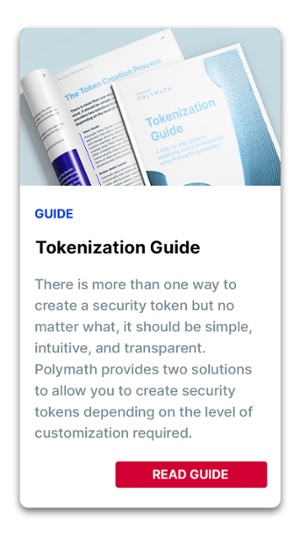When it comes to tokenizing assets on the blockchain, configuring a security token is only the beginning. You also need to ensure that transfer restrictions can be enforced and that your token can comply with regulatory requirements.
Tokenization might open the door to new kinds of products and attract new kinds of investors, but this does not mean issuers can construct their offering while neglecting regulations.
Following token configuration, it’s time to set compliance rules.
Tokenization might open the door to new kinds of products and attract new kinds of investors, but this does not mean issuers can construct their offering while neglecting regulations. Securities operations exist within a complex regulatory environment, and it’s important for issuers of security tokens to ensure their token and future transfers can meet them.
At minimum, issuers need to ensure that security tokens are compliant with KYC/AML requirements, as well as with securities regulations in whatever jurisdictions the token will be operating or trading in. There can be varying degrees of regulation depending on how issuers plan to raise funds, who from, and how much.
Polymath technology makes it easy for issuers to set compliance rules for a token and automate their enforcement. This helps issuers navigate complex compliance procedures while reducing the need for manual processes that are notoriously costly and time-consuming.
Let’s now explore the issues and benefits of compliance on blockchain, using Polymath’s technology as an example. We’ll then explore a few of its key features for compliance and their benefits.
Compliance on Blockchain
The financial industry spends an estimated $181b per year on compliance, and this number is only expected to increase as new and complex regulations are introduced. With new regulations around risk and compliance constantly being introduced, meeting compliance requirements becomes not only costly, but can be complex and confusing too.
 Better compliance is one of the major benefits promised by blockchain. Studies indicate that blockchain technology could cut compliance costs by up to 50%. But what makes compliance easier on blockchain compared to traditional processes?
Better compliance is one of the major benefits promised by blockchain. Studies indicate that blockchain technology could cut compliance costs by up to 50%. But what makes compliance easier on blockchain compared to traditional processes?
To begin with, the blockchain maintains a clear record of procedures and compliance activities for each client in a secure and immutable way. By automating the process, it can also reduce the risk of error or oversight. Overall, blockchain makes it easier and cheaper to manage complex compliance requirements or conduct a compliant raise.
Unfortunately, most chains have difficulty keeping up with the complex logic needed to comply with compliance requirements. While they can layer on further solutions, with the number and complexity of regulatory rules constantly increasing, this only threatens to push the chain to its computational limits. This ends up making the process costly and time-consuming.
In comparison, Polymesh gives issuers the flexibility to set rules around ownership and transfer requirements based on their specific needs and then automates their enforcement. This functionality is built into the chain’s core, bypassing the issue of complex layering facing other chains.
Pat LaVecchia, CEO of Oasis Pro Inc. (majority owner of Oasis Pro Markets), thinks this approach to compliance is one of the main benefits of Polymesh: “Polymesh is an attractive alternative that brings the benefits of blockchain, transparency and efficiency, while overcoming problems of compliance and confidentiality seen on public chains”.
Navigating complex compliance requirements can be tricky, and it’s important for blockchain technology not to make the process harder for issuers.
What's Involved in the Tokenization Process
Because compliance is built into the core of the Polymesh blockchain, issuers and investors benefit from faster processing and lower protocol fees that can scale as demand and complexity of regulation grows. This allows issuers to:
- Set ownership and transfer restrictions: Polymath gives issuers the flexibility to set rules around who can hold the token, how many investors can hold the token, and how it can be transferred. This includes token-based criteria (i.e. buy or sell lockups tied to when a token was issued) as well as identity-based criteria (i.e. residency or accreditation status).
- Select trusted attestation providers: Issuers need to consider how they will fulfill KYC/AML obligations. KYC providers attach attestations to the investor’s identity, which can be thought of as on-chain evidence verifying an attribute of a user’s identity (i.e. residency or accreditation) and are used to automate compliance rules around ownership and transfer.
- Systematically automate enforcement: Once the issuer inputs preferences, rules, and restrictions, Polymath’s technology automates their enforcement. Before permitting a transfer to take place, Polymesh checks to ensure all requirements are met and whether the buyer and seller have the right attestations tied to their identity. Because this functionality is built into the core of the chain rather than as an add-on, even very complex compliance requirements can be automated efficiently (and cost-effectively) at scale.
Navigating complex compliance requirements can be tricky, and it’s important for blockchain technology not to make the process harder for issuers. Polymesh makes the process easier by enabling issuers to set compliance rules that become programmed into the token’s code itself, meaning they can worry less about meeting ownership and transfer restrictions, fulfilling KYC/AML obligations, and enforcing requirements for future transfers.
Download our Tokenization Guide to learn more about tokenizing assets on the blockchain using Polymath technology.

